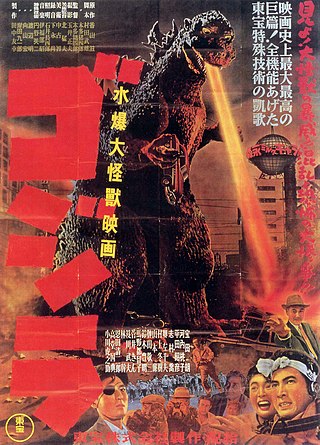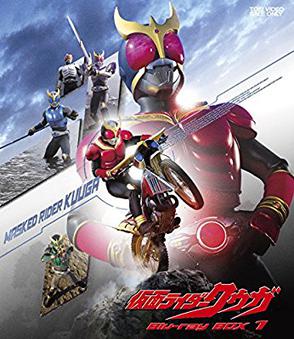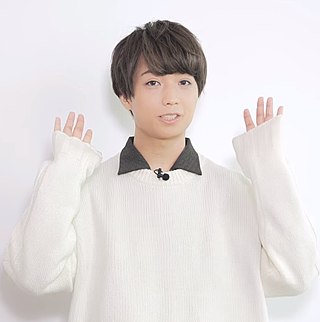
Jō Odagiri, better known by his stage name Joe Odagiri, is a Japanese actor. He is most famous for portraying Yusuke Godai, the titular hero of the 2000 tokusatsu series Kamen Rider Kuuga.

Kikaider is a manga series written and illustrated by Shotaro Ishinomori. A two-season tokusatsu series titled Android Kikaider was produced by Toei Company and Ishimori Productions in early 1970s. A 18-episode anime series based on the manga was created by Radix in early 2000s. The tokusatsu series from 1972 is especially popular in Hawaii.

Tokusatsu is a Japanese term for live-action films or television programs that make heavy use of practical special effects. Credited to special effects director Eiji Tsuburaya, tokusatsu mainly refers to science fiction, war, fantasy, or horror media featuring such technology but is also occasionally dubbed a genre itself. Its contemporary use originated in the Japanese mass media around 1958 to explain special effects in an easy-to-understand manner and was popularized during the "first monster boom" (1966-1968). Prior to the monster boom, it was known in Japan as Tokushu gijutsu or shortened Tokugi.

Shotaro Ishinomori was a Japanese manga artist who became an influential figure in manga, anime, and tokusatsu, creating several immensely popular long-running series such as Cyborg 009, the Super Sentai series, and the Kamen Rider series. He was twice awarded by the Shogakukan Manga Awards, in 1968 for Sabu to Ichi Torimono Hikae and in 1988 for Hotel and Manga Nihon Keizai Nyumon.

Kamen Rider Kuuga is a Japanese tokusatsu television series. It is the tenth installment of the popular Kamen Rider Series of tokusatsu shows and the first of the series to air entirely in the Heisei period, as well as the first standalone Kamen Rider TV series since Kamen Rider Black RX and the first series of the revived run of Kamen Rider, bringing Kamen Rider into the 21st century.

The Kamen Rider Series, also known as Masked Rider Series, is a Japanese superhero media franchise consisting of tokusatsu television programs, films, manga, and anime, created by manga artist Shotaro Ishinomori. Kamen Rider media usually revolves around the titular defined group of motorcycle-riding superheroes with an insect motif who fights supervillains, often known as kaijin.
Super Imaginative Chogokin is one of Bandai's popular line-up of die-cast metallic figurines (chogokin) based on the Kamen Rider franchise and other characters created by Shotaro Ishinomori and his production company. The figures are usually modified and differ from its counterpart as seen in the series. It is intended for those riders to closely resemble the ones portrayed in the manga and to have a much darker theme. S.I.C. figures are mostly sculpted by Takayuki Takeya and Kenji Ando.
The following is a glossary of terms that are specific to anime and manga. Anime includes animated series, films and videos, while manga includes graphic novels, drawings and related artwork.
Toshihiko Sahashi is a Japanese composer. He graduated from Tokyo National University of Fine Arts and Music in 1986. Sahashi has composed music for various anime series, video games, films, dramas, and musicals. His works include the original soundtracks for Zipang, Ghost Sweeper Mikami, Mobile Suit Gundam SEED, Mobile Suit Gundam SEED Destiny, Gunslinger Girl, Black Blood Brothers, Seijuu Sentai Gingaman, Kamen Rider Kuuga, Kamen Rider Agito, Kamen Rider Hibiki, Kamen Rider Den-O, Full Metal Panic!, Hunter × Hunter, Simoun, Reborn! and composed all three Saint Seiya anime series. Together with the London Symphony Orchestra, two symphonic albums have been released, each arranging his compositions from Gundam SEED and Gundam SEED Destiny. For the Mobile Suit Gundam franchise's 30th anniversary, he again collaborated with the London Symphony Orchestra for another symphonic music album.

Kamen Rider: The First is a 2005 Japanese tokusatsu superhero film. The film is a reboot adaptation of the television series Kamen Rider, though there are many differences between the film and the original programme; some of these, however, are due to a closer reliance on the original Kamen Rider manga by Shotaro Ishinomori. Written by Toshiki Inoue and directed by Takao Nagaishi, the film stars Masaya Kikawada as Takeshi Hongo/Kamen Rider 1 and Hassei Takano as Hayato Ichimonji/Kamen Rider 2.

Super Hero Time is a programming block on the Japanese television network TV Asahi featuring new episodes of tokusatsu television series from the Super Sentai and Kamen Rider. Both series have decades of history and have been intertwined in the public imagination for some time, not least of all because the driving creative force behind both was manga artist Shotaro Ishinomori and both were produced by the same production company, Toei Company; however, they did not air together until 2000 with Kamen Rider Kuuga and Kyuukyuu Sentai GoGoFive, though at the time they were not acknowledged together. Super Hero Time airs every Sunday morning, from 9:00 to 10:00 JST. The block is shown all over Japan via the All-Nippon News Network. Though, in other prefectures, one or both shows can be seen on other stations which are not affiliated with ANN.
Masayuki Tanaka is a Japanese singer. He was born in Imari, Saga Prefecture. He is one of the two original vocalists of the band Crystal King, known for their anime soundtracks such as Fist of the North Star where Tanaka provided the vocals in the chorus of its opening theme. After leaving Crystal King, he started his solo career and along the line lost his voice after being struck in the throat by a baseball and was never able to regain his original vocal range. In the late 1990s and early 2000s, he worked on the soundtracks of the tokusatsu series Ultraman Gaia and Kamen Rider Kuuga. He is also featured on the Katamari Damacy soundtrack Katamari Fortissimo Damacy where he sings "Katamari on the Rock", the main theme of the game.
Toshiki Inoue is a Japanese screenwriter from Saitama Prefecture. He is known for his work on anime and tokusatsu dramas and films. He is the son of Masaru Igami, who himself was a screenwriter for tokusatsu dramas. He is also a manga author, and has written both Mebius Gear and Sword Gai.

Kamen Rider Decade is the title of the first installment of the 2009 editions of the long-running Kamen Rider Series of tokusatsu dramas. Decade, as its title suggests, is the tenth of the Heisei Rider special anniversary Series, having begun with Kamen Rider Kuuga, it was also the final installment of the Heisei era's first phase. It began broadcasting the week following the finale of Kamen Rider Kiva and was featured in Super Hero Time alongside the 2009 edition of the Super Sentai Series, Samurai Sentai Shinkenger. Kamen Rider Zi-O, the last Heisei era series of 2018-2019, acts as a spiritual sequel, where both Decade and Diend play prominent roles as re-occurring side characters who are directly involved in that series plotline.
Ryouta Murai is a Japanese actor best known for his roles as Kojirō in Fūma no Kojirō, Kazuya Suzuki in Kamen Rider Den-O & Kiva: Climax Deka, Takuya Yano in Osananajimi and Yusuke Onodera in Kamen Rider Decade.
Keiichi Hasegawa is a Japanese screenwriter from Atami, Japan.
Naruhisa Arakawa is a Japanese screenwriter who primarily works on anime and tokusatsu dramas. He first served as a series' main writer for Blue Seed anime and the Kamen Rider Series revival Kamen Rider Kuuga. Arakawa was the main series writer for the Super Sentai anniversary series Kaizoku Sentai Gokaiger where he is also credited as a lyricist for the ending theme song with Shoko Fujibayashi. He also wrote the lyrics to "Detekoi Tobikiri Zenkai Power!", the first ending theme of Dragon Ball Z.

Magical girl is a subgenre of primarily Japanese fantasy media centered on young girls who possess magical abilities, which they typically use through an ideal alter ego into which they can transform.

Yuya Hozumi is a Japanese voice actor and singer from Fukushima Prefecture, affiliated with High Pine. He is known for portraying Uta Outa in Actors: Songs Connection, Keyarga in Redo of Healer, and Gildan in Seven Knights. In addition to voice acting, he is also a member of the musical group SparQlew.











